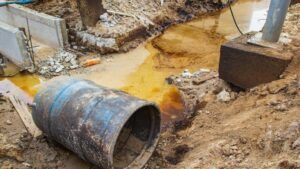The Risk-Based Standards for Kansas is a manual that details the processes of instating site-specific and chemical-specific clean-up goals for groundwater, soil and indoor air (Kansas Department of Health and Environment, 2010). The United States Environmental Protection Agency and other technical resources directives were used to determine the clean-up goals. An Environmental Workgroup established mandates for public and sector members before developing the RSK to set risk-based goals (Kansas Department of Health and Environment, 2021). Moreover, the main objective of the manual was to create consistent decisions that address contaminated sites controlled by the Kansas Department of Health and Environment.
The manual is used to evaluate the need for additional clean-up or assessment at contaminated sites in tandem with other site-specific conditions around Kansas (Kansas Department of Health and Environment, 2021). Moreover, it is used as a guide in risk-based clean-up mandates for groundwater and soil contaminants where the federal standards are not set. Nonetheless, the recommendations and procedures featured in the manual are consistent with national directives. They are set to assess possible human health risks caused by exposure to contaminants.
The RSK document was developed to aid Kansas Department of Health and Environment staff, volunteers, contractors and environmental consultants working on various sites (Kansas Department of Health and Environment, 2010). It helps them comprehend the basic principles of addressing possible public health disparities caused by contaminants. Additionally, it gives them a guide on the concepts of chemical vapour intrusion, which is fundamental to the environment’s safety. Notably, the document does not impose new policies but build upon existing practices that evaluate vapour intrusion and air impacts. It is not used for environmental assessments or environmental audits. The manual only applies to contaminated sites that are part of relevant clean-up programs. However, national and state regulation may be applicable at specific locations such as local public laws, groundwater management and compliance with regulations.
Risk-Based Environmental Standards for Kansas
All compiled environmental guidelines and standards are shown on the ESdat website. These are pre-loaded into ESdat Online.
ESdat is a specialist environmental database system; used to validate and import a broad spectrum of Environmental Data and help users analyze and report it.
ESdat Online delivers a highly cost-effective and efficient approach to store your ongoing monitoring environmental data, optionally with a historical data upload provided as a getting started service. ESdat Online is perfect if you want a cloud-based system that collates and reports your ongoing laboratory and field results.
ESdat Server provides the advantages of ESdat Online with the option of adding ESdat Desktop for data experts to upload their historical data, effectively interrogate the raw data being used within the database, and automatically launch and send data to other Desktop Applications such as Surfer, ArcGIS and Excel.
A variety of complementary products are also available to help with related work, such as sample planning and electronic Chain of Custody (LSPECS), offline field data collection or bore logging (pLog), production of bore logs (ESlog), public portals and customized reporting.
References
Kansas Department of Health and Environment. (2010). Risk‐based standards for Kansas, RSK Manual—5th Version.
Kansas Department of Health and Environment. (2021). Kansas Department of Health and Environment: Remedial Section. Kdheks.gov. Retrieved 1 November 2021, from https://www.kdheks.gov/remedial/rsk_manual_page.html






